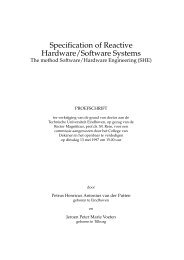A Calculator for Pareto Points
A Calculator for Pareto Points
A Calculator for Pareto Points
You also want an ePaper? Increase the reach of your titles
YUMPU automatically turns print PDFs into web optimized ePapers that Google loves.
§ ¥ ¨ <br />
¥ §¡ © ¨ <br />
§¨¦§¡ ¤¨ <br />
<br />
¢¢<br />
<br />
<br />
<br />
¤<br />
¤<br />
<br />
¥ §<br />
¢¡¤£¥¡¥¦§©¨<br />
¥ ¤ <br />
<br />
©<br />
<br />
© ¢© <br />
©<br />
<br />
<br />
<br />
<br />
<br />
<br />
<br />
©¤ © <br />
<br />
<br />
<br />
<br />
<br />
<br />
<br />
<br />
<br />
<br />
<br />
<br />
<br />
<br />
<br />
¡¥£¡¥¦§©¨<br />
<br />
¥ ¢ <br />
<br />
<br />
<br />
<br />
<br />
<br />
<br />
<br />
<br />
<br />
<br />
<br />
<br />
<br />
<br />
<br />
<br />
<br />
<br />
<br />
<br />
<br />
<br />
<br />
<br />
<br />
<br />
¤<br />
<br />
<br />
§ <br />
¤<br />
¤ ¥ <br />
<br />
<br />
<br />
<br />
<br />
<br />
<br />
<br />
<br />
<br />
¢© ¤<br />
<br />
<br />
¥¢ <br />
Figure 2. Example operations in a video application on a hand held device<br />
3. Implementing the <strong>Pareto</strong> Algebra<br />
In this section we discuss our implementation of the algebra,<br />
the selection of algorithms and generalisation of existing<br />
algorithms <strong>for</strong> this tool.<br />
3.1. Data Structure <strong>for</strong> Configuration Sets<br />
We need a data structure to store large sets (of size N)<br />
of configurations which has efficient procedures <strong>for</strong> inserting<br />
and removing configurations and <strong>for</strong> testing whether a<br />
configuration is included in the set (in O(log N)). We have<br />
used the ‘set’ class from the C++ Standard Template Library<br />
(STL)[1]. The set maintains a sorted list of elements<br />
and requires a sorting criterion <strong>for</strong> configurations. For this<br />
we select lexicographical ordering; per quantity an arbitrarily<br />
total order is used <strong>for</strong> this sorting.<br />
Many of the algorithms <strong>for</strong> the <strong>Pareto</strong> Algebra operators<br />
require sorting of the configurations wrt a particular totally<br />
ordered quantity. To support this, the tool can generate an<br />
index on the set <strong>for</strong> a particular quantity in O(N log N).<br />
3.2. Complexity of the Operators of the Algebra<br />
We review the complexity of the operators. The<br />
producer-consumer operator is discussed in the next section<br />
and minimisation in Section 5. The free product of a set C1<br />
(size M) and a set C2 (size N) of configurations has M · N<br />
configurations and can be constructed straight<strong>for</strong>wardly in<br />
O(M ·N ·log(M ·N)). The alternative computes the union<br />
of two sets in O((M + N) · log(M + N)).<br />
The constraint operator is defined as the intersection of<br />
two sets. Practical implementations may have an explicit<br />
representation of the constraint sets. Then the intersection<br />
can be computed directly by a merge. Often however, a constraint<br />
is implemented by a predicate, a characteristic function<br />
which tests (in constant time) whether a configuration<br />
belongs to the constraint set. In both cases the constraint is<br />
computed in O(N log N). Abstraction drops quantities of<br />
the configurations. This is straight<strong>for</strong>wardly implemented<br />
in time O(N · log N) (removing duplicates is required).<br />
The join operator consists of a product operation followed<br />
by a constraint. A direct implementation of this<br />
definition would first construct the cross product of the<br />
sets, only to remove (typically) many of the configurations<br />
with the constraint. The join is well-known in relational<br />
databases and algorithms are well-studied in that area [8].<br />
The main classes of join algorithms are sort-merge and hash<br />
based algorithms.<br />
We briefly discuss the sort-merge algorithm implemented<br />
in our calculator. Both configuration sets can be<br />
sorted in the dimension on which we want to join, by creating<br />
a sorted index. By merging both sorted lists, the configurations<br />
with matching values <strong>for</strong> the joined quantity can<br />
efficiently be found. Note that the worst-case complexity of<br />
the join is O(M · N · log(M · N)), since every point may<br />
have the same value <strong>for</strong> quantity Q. With very few matches,<br />
the algorithm works much more efficiently, converging to<br />
O((M + N) log(M + N)).<br />
4. Producer-Consumer Constraints<br />
An operator that can be implemented more efficiently is<br />
the producer-consumer combination (see Fig 2(a)-(d)). The<br />
straight<strong>for</strong>ward implementation of the mathematical definition<br />
is obtained by first constructing the product of both<br />
spaces, followed by applying the producer-consumer con-
















